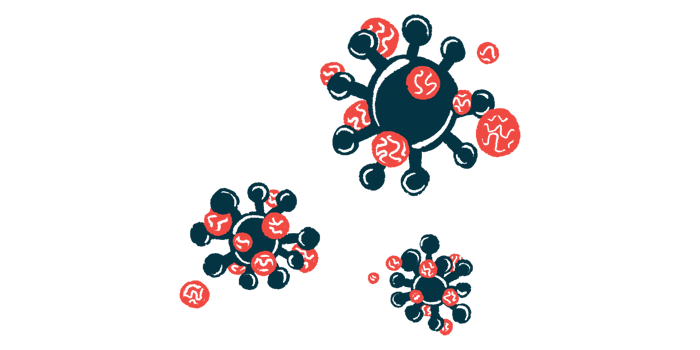CAD is most common AIHA type triggered by COVID-19: Review
Prompt steroid treatment found effective for COVID-19-induced AIHA
Written by |

Cold agglutinin disease (CAD) appears to be the most common type of autoimmune hemolytic anemia (AIHA) — a group of autoimmune diseases marked by attacks on red blood cells — that is triggered by COVID-19, according to a review of published studies.
Patients developed AIHA about 13 days after COVID-19 detection, and less than one-quarter showed at least one symptom related to the red blood cell destruction that marks CAD.
Available data on treatment regimens showed most of the patients who recovered had received corticosteroids, most commonly in combination with other treatments, including blood transfusions and rituximab.
‘Early recognition and prompt steroid therapy are critical’
“COVID-19 is associated with AIHA, often presenting with non-specific symptoms,” researchers wrote, adding that “early recognition and prompt steroid therapy are critical for improving outcomes.”
The review study, “Autoimmune hemolytic anemia in COVID-19 patients: A systematic review of 105 cases on clinical characteristics and outcomes,” was published in Clinical Immunology.
AIHA occurs when the body’s immune system produces self-reactive antibodies that bind to red blood cells, marking them for destruction in a process known as hemolysis. This results in anemia, where there are too few red blood cells to carry oxygen in the body.
The disease can be classified as CAD, warm AIHA, or mixed, depending on whether these antibodies attach to red blood cells at cold or warm temperatures, or a combination of both.
AIHA can be primary, meaning the cause is unknown, or secondary, when it is associated with an underlying condition, including other autoimmune conditions and viral infections, such as COVID-19.
To better understand the link between COVID-19 and AIHA, a team of researchers systematically reviewed studies published up to February 2025 on cases of newly diagnosed AIHA following COVID-19.
Overall, 85 studies, covering 105 people, were included in the meta-analysis. Most of the reported cases were from Asia. Participants were a mean age of 50.6 years, and more than half were men (54.3%). The mean time between COVID-19 and the first AIHA manifestation was 13.1 days.
A total of 72 people was tested for self-reactive antibodies linked to AIHA, which revealed 56.9% of them had CAD, 38.9% had warm AIHA, and 4.2% had mixed disease.
Participants had several signs of hemolysis, including lower-than-normal mean levels of hemoglobin, the protein in red blood cells that transports oxygen, and higher-than-normal counts of immature red blood cells and blood levels of lactate dehydrogenase.
Patients reported symptoms commonly related to COVID-19
Nearly all patients reported symptoms most commonly related to COVID-19 (87.7% of patients), including fever, cough, shortness of breath, partial or full smell loss, or fatigue.
About 24.4% of cases showed at least one symptom related to hemolysis, including pallor, yellowish discoloration, or dark urine. “This pattern contrasts with primary AIHA, where hemolytic manifestations are more pronounced at onset of diagnosis,” the team wrote.
A total of 89 cases had available data on treatment approaches, and 82 patients had recovered, which was defined in most studies as an increase in hemoglobin, normalization of hemolysis markers, and a reduction in symptoms.
Treatment lasted an average of 23 days, and patients were in remission or stabilized after about 19 days on average (range of one to 88 days).
Most of those who recovered (95%) were given corticosteroids, a type of anti-inflammatory and immunosuppressive medication, alone or in combination with other treatments. The recovery rate among the 18 cases treated with corticosteroids alone was 88.9%, and this increased to 92% among the 12 people given corticosteroids plus blood transfusions.
All patients receiving a combination of corticosteroids plus rituximab, with or without blood transfusions, recovered. The same occurred for all of those given corticosteroids, blood transfusions, and intravenous immunoglobulins (IVIG).
Rituximab promotes the death of B-cells, which are the immune cells that produce the self-reactive antibodies that cause AIHA. IVIG involves administering healthy antibodies to neutralize those self-reactive antibodies.
“The findings highlight the predominant use of steroids, which were associated with improved outcomes, and underscore the importance of timely intervention,” the researchers wrote. “Recovery rates were significantly higher in patients who received combined therapies.”
A total of 15 people died, “representing a mortality rate of 14.3%, which is higher than that of the general COVID-19 population,” the team wrote.
Most deaths (66.7%) were mainly associated with COVID-19-related complications rather than AIHA alone. Still, death was deemed directly related to severe hemolysis in four people (26.7%).
“Physicians should maintain a high index of suspicion for AIHA in COVID-19 patients and consider comprehensive treatment strategies, particularly for those with preexisting conditions, to enhance patient care and outcomes,” the researchers wrote. “Further research is needed to guide management.”




